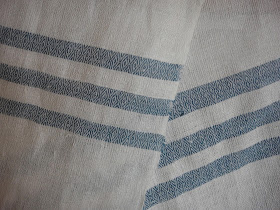 I think warping the shawl took longer than actually weaving. The weave is the same diamond twill used for the Preugia towel, set at 16 EPI. There are a total of 524 warp ends. This seemed like a paltry number of warps after the 1200+ I had to deal with for the linen towel, but still it took more than half the season of DA to thread them all. Once that was done the weaving went very smoothly. It was a lot of fun to see how the colors in the hand spun changed, and how the different skeins of hand spun varied since each spinner dealt with the color variation a little bit differently. I am mostly pleased with my selvages, there are some places that are better than others but I think I have an idea of how to improve that next time. I just need to figure out where to get fishing line. Twisting the fringe took awhile but it's nice and mindless and I got a nifty little fringe twister from an etsy seller that made the processes a bit easier. It's not hard to do this by hand but after awhile it's murder on the fingers and the tool helps with that. Plus the twists are much more even where I used the tool.
I think warping the shawl took longer than actually weaving. The weave is the same diamond twill used for the Preugia towel, set at 16 EPI. There are a total of 524 warp ends. This seemed like a paltry number of warps after the 1200+ I had to deal with for the linen towel, but still it took more than half the season of DA to thread them all. Once that was done the weaving went very smoothly. It was a lot of fun to see how the colors in the hand spun changed, and how the different skeins of hand spun varied since each spinner dealt with the color variation a little bit differently. I am mostly pleased with my selvages, there are some places that are better than others but I think I have an idea of how to improve that next time. I just need to figure out where to get fishing line. Twisting the fringe took awhile but it's nice and mindless and I got a nifty little fringe twister from an etsy seller that made the processes a bit easier. It's not hard to do this by hand but after awhile it's murder on the fingers and the tool helps with that. Plus the twists are much more even where I used the tool.The fabric was finished with a cold water and Eucalan soak to preserve the sheen of the hand spun wool. HRM will need to hand wash or dryclean this going forward but I think she can manage that. The sample I wove was lightly fulled and it looked ok but lost a lot of the beautiful shine that the mohair in the hand spun gave the piece, so I went with a simpler finishing. If she does accidentally full it a bit it won't damage it any, the thing is pretty big and she's not a tall woman so it will still look nice on her.

Overall this was a really fun project. Not being 100% sure what sort of yarn I was going to get from the spinners was both fun and stressful, but I really enjoyed the collaborative aspect of the project. Now that I have a better idea of what to expect and how to plan, I am looking forward to doing this again in the future. I've already got some ideas for future project percolating away in the back of my head!








